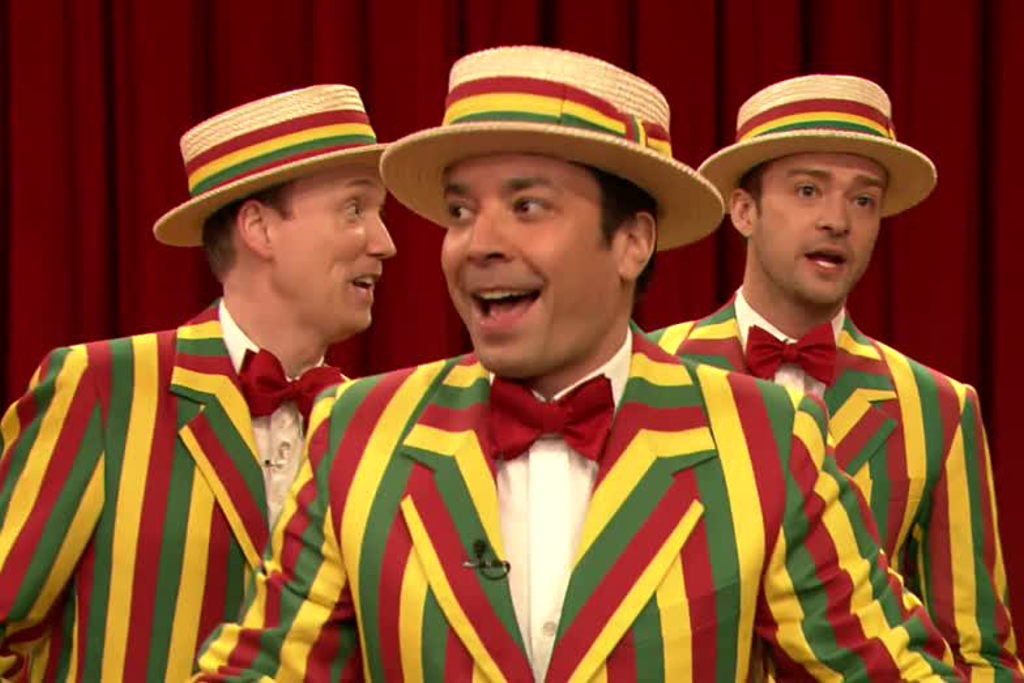Jimmy Fallon’s Success Proves We Don’t Want To Watch Old Guys Sit And Talk Anymore
The key to talk show success in 2014? Less 'talk', more 'show'.

It’s fairly undeniable that Jimmy Fallon is currently killing it as the new host of The Tonight Show, and a new study shines a light on why this may be: he shuts up more often than other talk show hosts. In other words, less talk, more show.
The Tonight Show spends only 37% of airtime on the ‘talk’ portion of the show, which is defined in this study as being when Fallon is sitting, talking to guests. This is markedly less time spent behind the desk than Jimmy Kimmel’s 48%, David Letterman and Seth Meyers’ 51% apiece, and Conan O’Brien’s 53%. Craig Ferguson is the closest to Fallon, at 43%.
–
Interestingly the 51% mark seems to have been the norm for The Tonight Show for years, with Fallon’s two most notable predecessors, Jay Leno and Johnny Carson, each hitting that magic percentage point. It is no mistake that the Late Show with David Letterman also sits at 51% talk; the show launched in 1993 as a competitor to The Tonight Show, an awesomely spiteful move made after NBC passed Letterman over as Carson’s Tonight Show replacement, in favour of Leno. This is the late night talk show formula, set by Carson in 1962, and the old guys seem determined to stick to it.
Of course, the media landscape is rapidly changing, and Fallon’s brand of The Tonight Show both moves with the times – by consistently offering up celebrity-drenched web-friendly content – and kicks against them, by harking back to an older style of television entertainment, that of the variety hour: songs, dances, skits, parodies, celebrity cameos, and a general tone of silliness.
Jimmy Fallon is, put simply, a song-and-dance man. His Tonight Show is a Ritalin-rollercoaster, and this frantic pace dictates the tone. This approach betrays both Fallon’s seven seasons on SNL, and his early training with noted improv. group The Groundlings. It’s no wonder he barely spends a third of the show in the host’s seat; there’s too much other space to play in.
–
There is also a refreshing lack of cynicism or snark on the Fallon-driven Tonight Show. While Letterman tiredly leans on his sarcastic, dry old man routine, and Leno was simply waiting for the gaps between guests’ words to pounce, Fallon’s show is about inclusion, about fun.
He also respects his audience, which sits in direct constant to the approach of Jimmy Kimmel, another late night star aiming for the same demographic as Fallon. Kimmel has gotten great traction from his vox-pop series ‘Lie Witness News’ – a segment where members of the public are made to reveal their own lack of knowledge, for the supposed glee of the viewing audience. You can feel the smug superiority dripping off Kimmel as he throws to these clips.

There’s no such air of superiority on the Tonight Show set. Stars are eager to participate because Fallon eggs them on, allowing them to let their hair down and showcase a less serious side without the feeling they are the butt of the joke. There’s nothing more awkward than watching a celebrity feign good-humour while a bitter old talk show host tosses cheap, writers’-room-approved barbs at them. As Fallon pointed out in a January Vulture feature, “I never do anything sneaky or try to make guests look bad or try to trick them.”
It’s not surprising Fallon’s freewheelin’ brand of late night silliness holds more appeal than old white men sitting behind desks, talking themselves obsolete. Who knew the future of late night television involved barbershop quartets, and pop parodies? It all does makes a silly sort of sense, though.